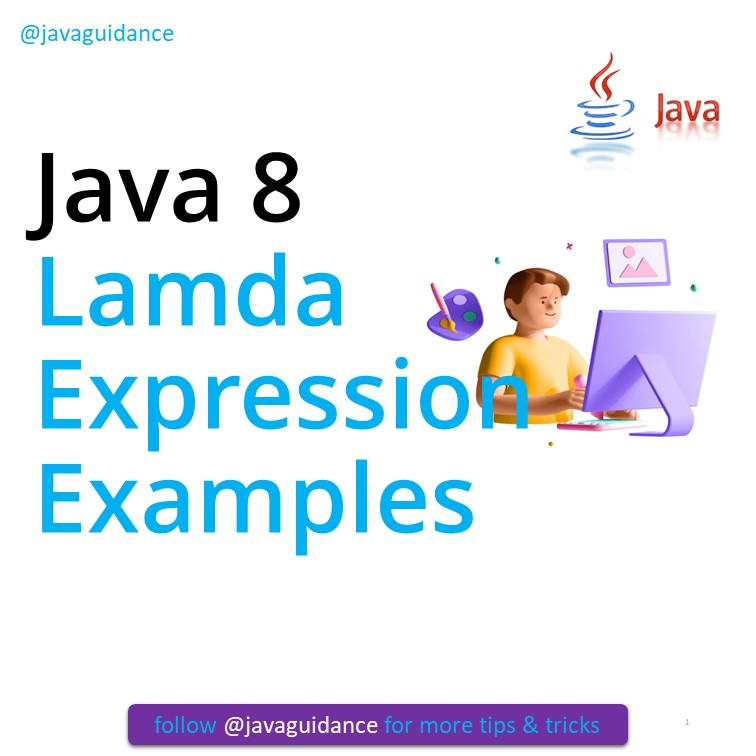Writing Various Forms of Lambda Expressions in Java
Lambda expressions have brought a breath of fresh air to Java programming, allowing developers to write more concise and expressive code. In this article, we’ll delve into the world of lambda expressions, exploring different forms and how they can be used to enhance your Java applications.
Introduction to Lambda Expressions
Lambda expressions provide a concise way to represent a block of code as an expression. They are especially useful for implementing single-method interfaces, often referred to as functional interfaces, in a more elegant manner.
Example :
Lambda expressions provide a concise way to represent a block of code as an expression. For instance, a simple lambda expression to calculate the square of a number can be:
Function<Integer, Integer> square = x -> x * x; int result = square.apply(5); // Result: 25
Syntax of Lambda Expressions
The syntax of a lambda expression consists of parameters, an arrow (->), and a body. For instance, (x, y) -> x + y represents a lambda expression that takes two parameters and returns their sum.
Example :
The syntax of a lambda expression consists of parameters, an arrow (->), and a body. For example, a lambda expression to add two numbers:
BinaryOperator<Integer> add = (x, y) -> x + y; int sum = add.apply(10, 20); // Sum: 30
Writing Lambda Expressions with Parameters
Lambda expressions can accept zero or more parameters. You can explicitly specify parameter types or rely on type inference. For example, (int x, int y) -> x * y and (a, b) -> a + b are both valid expressions.
Example :
Lambda expressions can accept parameters with or without explicit types. Here’s a lambda expression for finding the maximum of two numbers:
BinaryOperator<Integer> max = (a, b) -> a > b ? a : b; int maxValue = max.apply(15, 8); // Max Value: 15
Utilizing Lambda Expressions with Streams
Lambda expressions are often used in conjunction with Java Streams, enabling concise and powerful operations on collections. They streamline operations like filtering, mapping, and reducing elements.
Example :
Lambda expressions are commonly used with streams. Here’s an example using a stream to filter and collect even numbers:
List<Integer> numbers = Arrays.asList(1, 2, 3, 4, 5, 6, 7, 8);
List<Integer> evenNumbers = numbers.stream()
.filter(n -> n % 2 == 0)
.collect(Collectors.toList());
Lambda Expressions vs. Anonymous Inner Classes
Lambda expressions provide a more concise syntax compared to anonymous inner classes. They eliminate the need for cumbersome boilerplate code, making your codebase cleaner and more readable.
Example:
Lambda expressions provide a cleaner alternative to anonymous inner classes. Here’s a comparison of sorting with both approaches:
Using Lambda Expression:
List<String> names = Arrays.asList("Alice", "Bob", "Charlie");
Collections.sort(names, (a, b) -> a.compareTo(b));
Using Anonymous Inner Class:
List<String> names = Arrays.asList("Alice", "Bob", "Charlie");
Collections.sort(names, new Comparator<String>() {
public int compare(String a, String b) {
return a.compareTo(b);
}
});
Combining Lambda Expressions and Functional Interfaces
Functional interfaces, interfaces with a single abstract method, are key players in lambda expressions. Java provides built-in functional interfaces like Runnable, Predicate, and Consumer that can be utilized effectively with lambda expressions.
Example : Functional interfaces can be easily combined with lambda expressions. Here’s an example using the Function interface:
Function<Integer, String> convertToString = num -> String.valueOf(num); String strValue = convertToString.apply(42); // Result: "42"
Using Method References with Lambda Expressions
Method references offer an even more concise way to express lambda expressions for methods that already have a name. They can make your code more elegant by referring to methods directly.
Example: Method references provide a more concise syntax for invoking methods. Here’s an example using the toUpperCase method:
List<String> names = Arrays.asList("Alice", "Bob", "Charlie");
names.forEach(System.out::println);
The “this” Reference in Lambda Expressions
In lambda expressions, the this keyword refers to the instance of the functional interface itself. This can sometimes lead to unexpected behavior, especially when dealing with inner classes.
Example :
In lambda expressions, this refers to the instance of the functional interface. Here’s an example demonstrating this in an instance method:
public class MyClass {
public void printMessage() {
Runnable r = () -> System.out.println(this.toString());
new Thread(r).start();
}
}
Lambda Expressions for Multithreading
Lambda expressions simplify the creation of anonymous inner classes, making multithreading tasks more streamlined. They are commonly used in creating threads and running tasks concurrently.
Example:
Lambda expressions simplify multithreading. Here’s an example using a lambda expression to create and start a new thread:
Runnable task = () -> {
for (int i = 0; i < 5; i++) {
System.out.println("Thread is running: " + i);
}
};
Thread thread = new Thread(task);
thread.start();
Exception Handling with Lambda Expressions
Lambda expressions can handle exceptions within their body. However, you need to be cautious about checked exceptions, as they can lead to unhandled exceptions if not properly managed.
Example :
Lambda expressions can handle exceptions within their body. Here’s an example with a lambda expression inside a try-catch block:
Consumer<Integer> printSquare = num -> {
try {
int result = num * num;
System.out.println("Square: " + result);
} catch (Exception e) {
System.err.println("Error: " + e.getMessage());
}
};
Best Practices for Writing Lambda Expressions
- Keep lambda expressions short and focused.
- Utilize meaningful parameter names.
- Avoid complex logic within lambda bodies.
- Be mindful of variable captures and their lifecycle.
Conclusion
Lambda expressions have undoubtedly transformed the Java programming landscape. They offer a concise and expressive way to write code, enhancing readability and reducing boilerplate. By mastering the various forms of lambda expressions, you can become a more efficient and effective Java developer.
FAQs
- Q: Can lambda expressions replace anonymous inner classes entirely? A: Lambda expressions are a more concise and readable alternative to anonymous inner classes, especially for functional interfaces.
- Q: Are lambda expressions thread-safe? A: Lambda expressions are inherently thread-safe, as long as they don’t modify shared state. Proper synchronization should still be applied when necessary.
- Q: Can lambda expressions be used in Android app development? A: Yes, lambda expressions are supported in Java 8 and higher, which includes Android development.
- Q: How do method references enhance lambda expressions? A: Method references provide a more compact syntax for invoking existing methods, making your code more streamlined.
- Q: Are lambda expressions suitable for complex business logic? A: While lambda expressions are great for concise operations, complex business logic might be better organized in separate methods for clarity.
In this article, we’ve explored the versatility and power of lambda expressions in Java. By understanding their syntax, forms, and best practices, you can leverage them to write more efficient and expressive code, ultimately enhancing your Java programming skills.




Very interesting information!Perfect just what I was searching for!?